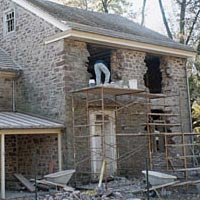
Windows being replaced during restoration, 1999 Photo: Murrie Gayman |
Moland House
Built circa 1750, this stone farmhouse was
constructed on banks of the Little Neshaminy Creek by John Moland,
a Provincial Councillor and attorney in Bucks County, Pennsylvania;
the house remained in the Moland family until 1790. During 1777
George Washington made the house his headquarters during a 13-day
encampment of the Continental Army. During that encampment, the
young Marquis de Lafayette and Count Pulaski first joined the
Continental Army. Upon leaving the Moland house, George Washington
and the Continental Army embarked on a path that led to the Battles
of Brandywine and Germantown, and the winter at Valley Forge.
During the late 19th and early 20th centuries, the
Moland House was recognized as an important landmark. Although it
remained a private residence, the Moland house was the site of
meetings of history-interested groups during the first half of the
20th century. The Sons of the Revolution and a group of French
educators and military officers taking part in the Lafayette
College Centennial Celebration met there in 1903 and 1932,
respectively. Sometime during the 1960s or early 70s Moland house
ceased to be a private residence, and became a rooming house. It
fell into disrepair and by 1985 was abandoned. It was then that a
concerned group of local citizens began to take action.
Through their efforts, the house was placed on the
National Register of Historic Places, and a documentary was
produced to rally support to save the house from demolition. In the
fall of 1996, a local tradition began: a Saturday morning work
session to prepare the house for restoration. In May 1997, with the
signing of an agreement with Warwick Township, the Warwick Township
Historical Society was given the responsibility of preserving the
Moland House.
The house had undergone significant renovations and
additions during the 1870s and 1940s, and much of the original
structure had been changed or hidden. The Society hired an
architectural firm specializing in the renovation of historic
buildings to accomplish the preservation and restoration of the
structure. The architects first determined the evolution of the
building so it could be restored accurately. By 1999, the
renovation of the outside of the house had been accomplished; the
new phase will begin an historically accurate restoration of the
interior. The house and its surrounding 12 acres have also become
the subject of an active archaeological exploration. The tide has
turned for the Moland House; within a few years the house will be
completely restored and take its rightful place in American
history.
Project is documented by a videotape "Save the Moland
House"; an edition of the Warwick Township Historical Society:
Headquarters Farm at the Crossroads; a six-page essay;
several pages of background on the Warwick Township Historical
Society; thirteen 8 x 10 color photographs; newspaper articles; and
copies of the
Moland Gazette, a biannual newsletter
published by the Warwick Township.
Originally submitted by: James C. Greenwood, Representative (8th District).
 More Local Legacies... More Local Legacies... |
|
|
|
The Local Legacies project provides a "snapshot" of American Culture as it was expressed in spring of 2000. Consequently, it is not being updated with new or revised information with the exception of "Related Website" links.
 Learn More About It... Learn More About It... |
|
|
|
|